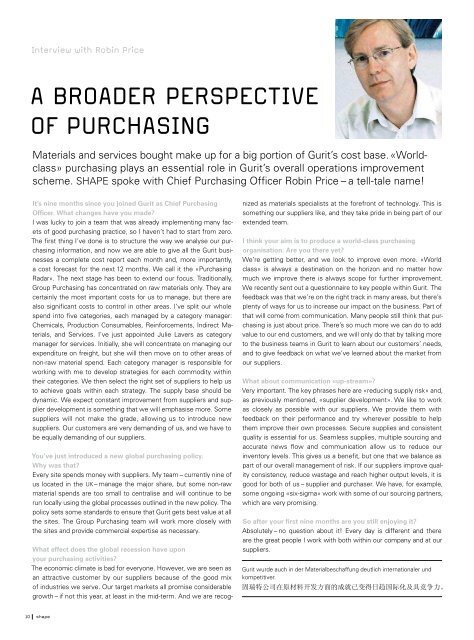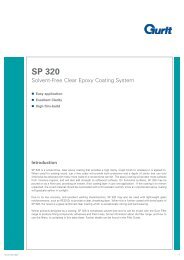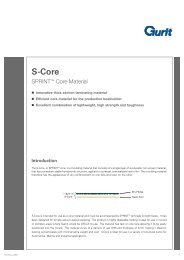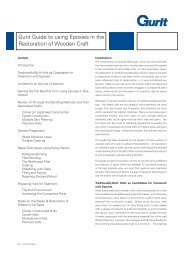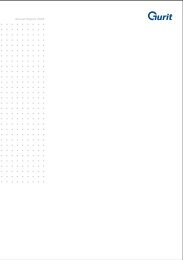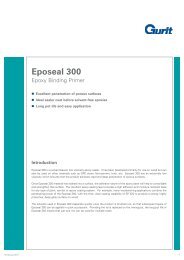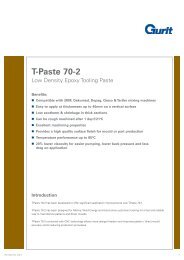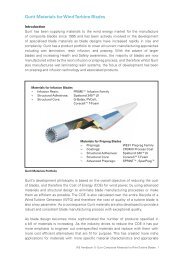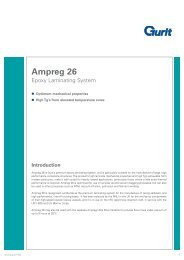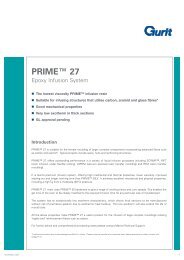Shape - Gurit
Shape - Gurit
Shape - Gurit
Create successful ePaper yourself
Turn your PDF publications into a flip-book with our unique Google optimized e-Paper software.
interview with robin price<br />
a Broader perspeCTive<br />
of purChasiNG<br />
Materials and services bought make up for a big portion of <strong>Gurit</strong>’s cost base.«Worldclass»<br />
purchasing plays an essential role in <strong>Gurit</strong>’s overall operations improvement<br />
scheme. s h a p e spoke with Chief Purchasing Officer Robin Price – a tell-tale name!<br />
It’s nine months since you joined <strong>Gurit</strong> as Chief Purchasing<br />
Officer. What changes have you made?<br />
I was lucky to join a team that was already implementing many facets<br />
of good purchasing practice, so I haven’t had to start from zero.<br />
The first thing I’ve done is to structure the way we analyse our purchasing<br />
information, and now we are able to give all the <strong>Gurit</strong> businesses<br />
a complete cost report each month and, more importantly,<br />
a cost forecast for the next 12 months. We call it the «Purchasing<br />
Radar». The next stage has been to extend our focus. Traditionally,<br />
Group Purchasing has concentrated on raw materials only. They are<br />
certainly the most important costs for us to manage, but there are<br />
also significant costs to control in other areas. I’ve split our whole<br />
spend into five categories, each managed by a category manager:<br />
Chemicals, Production Consumables, Reinforcements, Indirect Materials,<br />
and Services. I’ve just appointed Julie Lavers as category<br />
manager for services. Initially, she will concentrate on managing our<br />
expenditure on freight, but she will then move on to other areas of<br />
non-raw material spend. Each category manager is responsible for<br />
working with me to develop strategies for each commodity within<br />
their categories. We then select the right set of suppliers to help us<br />
to achieve goals within each strategy. The supply base should be<br />
dynamic. We expect constant improvement from suppliers and supplier<br />
development is something that we will emphasise more. Some<br />
suppliers will not make the grade, allowing us to introduce new<br />
suppliers. Our customers are very demanding of us, and we have to<br />
be equally demanding of our suppliers.<br />
You’ve just introduced a new global purchasing policy.<br />
Why was that?<br />
Every site spends money with suppliers. My team – currently nine of<br />
us located in the u k – manage the major share, but some non-raw<br />
material spends are too small to centralise and will continue to be<br />
run locally using the global processes outlined in the new policy. The<br />
policy sets some standards to ensure that <strong>Gurit</strong> gets best value at all<br />
the sites. The Group Purchasing team will work more closely with<br />
the sites and provide commercial expertise as necessary.<br />
What effect does the global recession have upon<br />
your purchasing activities?<br />
The economic climate is bad for everyone. However, we are seen as<br />
an attractive customer by our suppliers because of the good mix<br />
of industries we serve. Our target markets all promise considerable<br />
growth – if not this year, at least in the mid-term. And we are recog-<br />
nized as materials specialists at the forefront of technology. This is<br />
something our suppliers like, and they take pride in being part of our<br />
extended team.<br />
I think your aim is to produce a world-class purchasing<br />
organisation. Are you there yet?<br />
We’re getting better, and we look to improve even more. «World<br />
class» is always a destination on the horizon and no matter how<br />
much we improve there is always scope for further improvement.<br />
We recently sent out a questionnaire to key people within <strong>Gurit</strong>. The<br />
feedback was that we’re on the right track in many areas, but there’s<br />
plenty of ways for us to increase our impact on the business. Part of<br />
that will come from communication. Many people still think that purchasing<br />
is just about price. There’s so much more we can do to add<br />
value to our end customers, and we will only do that by talking more<br />
to the business teams in <strong>Gurit</strong> to learn about our customers’ needs,<br />
and to give feedback on what we’ve learned about the market from<br />
our suppliers.<br />
What about communication «up-stream»?<br />
Very important. The key phrases here are «reducing supply risk» and,<br />
as previously mentioned, «supplier development». We like to work<br />
as closely as possible with our suppliers. We provide them with<br />
feedback on their performance and try wherever possible to help<br />
them improve their own processes. Secure supplies and consistent<br />
quality is essential for us. Seamless supplies, multiple sourcing and<br />
accurate news flow and communication allow us to reduce our<br />
inventory levels. This gives us a benefit, but one that we balance as<br />
part of our overall management of risk. If our suppliers improve quality<br />
consistency, reduce wastage and reach higher output levels, it is<br />
good for both of us – supplier and purchaser. We have, for example,<br />
some ongoing «six-sigma» work with some of our sourcing partners,<br />
which are very promising.<br />
So after your first nine months are you still enjoying it?<br />
Absolutely – no question about it! Every day is different and there<br />
are the great people I work with both within our company and at our<br />
suppliers.<br />
<strong>Gurit</strong> wurde auch in der Materialbeschaffung deutlich internationaler und<br />
kompetitiver.<br />
固瑞特公司在原材料开发方面的成就已变得日趋国际化及具竞争力。<br />
CaTia reduCes desiGN<br />
aNd developMeNT TiMe<br />
The <strong>Gurit</strong> Automotive team had first been using an entry-level c a d tool. They have<br />
now made the switch to c at i a. Sharing design information with o e m s using the<br />
same data format greatly facilitates cooperation.<br />
Advising customers on composite-specific design matters for their<br />
components is a key part of <strong>Gurit</strong>’s offering as a tier 1 automotive<br />
supplier. Small changes in edge condition or draft angles can have<br />
a significant impact on a composite component’s manufacturability<br />
and price. Effective use of c a d , both as an analysis tool and a means<br />
of communication between design teams, underpins this process.<br />
Once the component geometry is finalised, c a d work on tooling concepts<br />
begins. This is largely an iterative process with inputs from the<br />
customer, from <strong>Gurit</strong> engineers and the toolmaker’s own design<br />
team. Historically, <strong>Gurit</strong> had worked with an easy-to-use and relatively<br />
inexpensive entry-level system as its primary 3d c a d system.<br />
«We used this system to develop the design of the production tools<br />
for the current Aston Martin d b s coupé,» says Martin Starkey, Managing<br />
Director of <strong>Gurit</strong> Automotive. Interim designs are frequently<br />
exchanged and modified by all parties prior to final design sign-off.<br />
«With time, it became obvious, that our system did not fully fulfill<br />
all the requirements for day to day tasks in the demanding automotive<br />
environment. Especially the creation of files for data exchange<br />
resulted in abnormally large files impeding cross communication<br />
between <strong>Gurit</strong> and its partners.»<br />
CoMMuNiCaTiNG iN CaTia<br />
Two c a d systems are pre-eminent in the automotive industry:<br />
i-d e a s was largely driven by the Ford Motor Company, merged with<br />
the Unigraphics n x series of c a d systems and continues to be used<br />
at Ford and other companies. c at i a Version 4 and Version 5 have<br />
been adopted by a large number of automotive o e m s and are rapidly<br />
becoming a de facto standard for automotive design. Communicat-<br />
ing in c at i a native file formats is a condition of becoming a tier 1<br />
supplier for many o e m s. <strong>Gurit</strong> has therefore opted for c at i a v5. «Our<br />
system went live in November 2008 with onsite support and training<br />
in its fundamental operation,» Alan Purves, Account Engineering<br />
Design Manager remembered. Further, automotive-specific advanced<br />
training took place at the supplier in April 2009. The huge<br />
variety of c at i a modules offers scope to integrate other processes<br />
and gain further improvements in productivity, for example programming<br />
of c n c cutter paths for future projects could be accomplished<br />
from within c at i a using the Machining Workbench. A key part of the<br />
development of c at i a has been to integrate composites manufacturing<br />
and design operations, and the Composites Workbench allows<br />
ply shapes to be generated, developed and cut from within a c at i a<br />
environment.<br />
speediNG up desiGN aNd developMeNT<br />
TiMe for asToN MarTiN’s dBs volaNTe<br />
After completion of the basic training course, B-surface tool design<br />
work was undertaken for <strong>Gurit</strong>’s involvement in the Aston Martin<br />
d b s Volante project, and the value of the investment in c at i a and<br />
associated training rapidly became clear: Using the former 3d package<br />
for the d b s Coupé had taken approximately 50 man hours. Using<br />
c at i a v5, a similar task for d b s Volante took just nine man hours.<br />
Tool design for the d b s Volante model represented a significant progression<br />
for <strong>Gurit</strong> as the global leading carbon fibre parts supplier.<br />
«Through further development across all our processes and deployment<br />
of powerful tools such as c at i a, the time taken from design<br />
freeze to parts production has effectively been halved,» concluded<br />
Martin Starkey.<br />
10 shape<br />
The <strong>Gurit</strong> Magazine 05_2009 11<br />
TechTalk<br />
Der Wechsel zur c a d -Software c at i a<br />
erleichtert die Zusammenarbeit zwischen<br />
<strong>Gurit</strong> und Autobauern.<br />
CAD制图软件CATIA的采用,大大促<br />
进了与汽车客户之间的合作。


